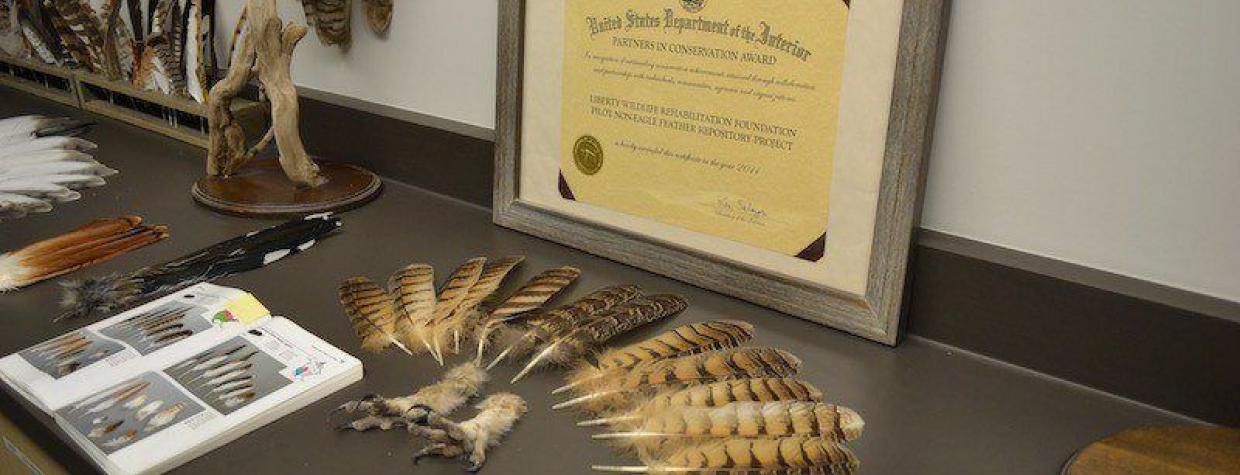Robert Mesta may have retired from the U.S. Fish and Wildlife Service after nearly 40 years, but he certainly hasn’t stopped working.
Mesta is the coordinator of Liberty Wildlife’s Non-Eagle Feather Repository Program. Since 2010, the nonprofit group — in cooperation with the Fish and Wildlife Service — has worked to legally provide Native Americans with a source of non-eagle feathers for ceremonial, religious and healing purposes.
The group gathers feathers from molting birds at Liberty Wildlife's facility, but also relies on contributions from other rehabilitators, the Fish and Wildlife Service, the Arizona Game and Fish Department, falconers, museums and zoos, Mesta said.
“The significance of this particular program is that for almost 100 years, Native Americans haven’t had a legal vehicle to obtain non-eagle feathers for ceremonial and religious purposes,” he explained.
According to Liberty Wildlife, unregulated trapping, hunting, poisoning and loss of habitat threatened North America’s birds throughout the 1800s, resulting in a number of laws being enacted to stop the decline and protect native bird species.
While the laws helped to protect wildlife, they also had unintended consequences: Native Americans were longer able to collect birds or feathers for cultural purposes, and a black market for bird feathers and parts was created, Mesta said.
The effect on Native Americans was apparent, as birds and their features are an integral part of many tribes' cultures.
“Native Americans were one with their environment. They depended on those animals — not only for sustenance, food or clothing, but they also relied on those animals, and particularly birds, to help sustain them spiritually,” Mesta said. “Over the years, a lot of ceremonies and dances that involved bird feathers were lost, or at least compromised or maybe not performed as frequently, because there was no source of feathers in order to construct regalia or ceremonial implements that were necessary.”
Mesta credits Benjamin Tuggle, regional director for the Fish and Wildlife Service’s Southwest Region, with helping to get the program developed.
“The Fish and Wildlife Service over the years had recognized the situation, but no one had really wanted to step forward and look at what might be a proactive solution," he said. "Up until the repository first got going in 2010, the action taken was reactive, which meant law enforcement went out and arrested people that were selling feathers illegally.
“This was the first opportunity to take proactive measures. And by that, I mean we were actually collecting feathers, holding feathers and then providing [them] through an application process to Native Americans. By doing that, we’re giving them an alternative to buying them illegally through the black market."
Native Americans can apply for bird feathers or parts through Liberty Wildlife’s application process. Certificates of authorization accompany the shipments to show the recipients received the feathers or parts legally.
According to Mesta, the program has provided more than 3,000 feathers to 171 different tribes in 47 states.
“This year, we filled over 80 percent of the orders that came in, compared to only 39 percent to last year,” he said. The ability to expand orders filled and the program itself have been enhanced by Liberty Wildlife’s new facility, which opened this fall.
“We didn’t even have a building before; we did our stuff outside," Mesta said. "Now, we actually have an office where people can come sit down and work."
Mesta's future plans include things that require a healthy budget. He wants to create an internship program for Native American students, as well as an accredited college course that would teach students to care for the birds, help rehabilitate, teach feather identification and explain the cultural significance of the feathers.
“We can send out feathers, and that’s great, but this program has so much potential to do more things, and that’s one example of how I see us benefiting Native American cultures in addition to providing feathers for ceremonial purposes," he said.
Mesta said the volunteers of Liberty Wildlife are proud to be correcting a situation that is almost a century old.
As Mare VanDyke, a volunteer and assistant to Mesta, put it: “[We’re] giving life to feathers that can no longer fly.”
— Kirsten Kraklio
To learn more about Liberty Wildlife's Non-Eagle Feather Repository Program, visit www.non-eaglefeathers.net.

